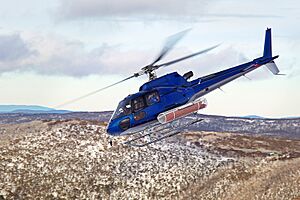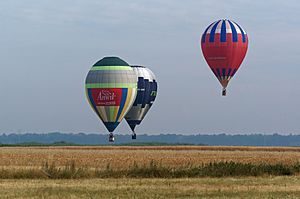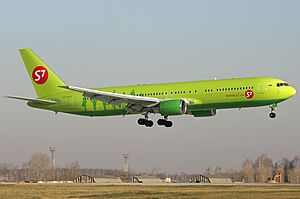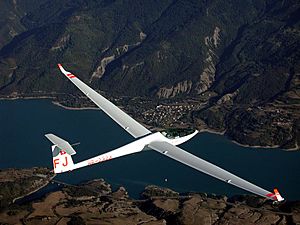Air travel facts for kids

Air travel is when people or things move from one place to another using flying objects. This includes airplanes, helicopters, hot air balloons, and other machines that can fly.
For a very long time, people dreamed of flying. They watched birds and tried many ways to take to the sky. Eventually, they invented balloons and flying machines. Air travel has made journeys much faster and cut down travel time a lot. Today, you can travel around the world in about 24 hours. This was impossible with any other type of transport before.
Today, flying is a common way to travel. People fly for fun, for personal reasons, or for business trips.
Contents
Types of Flights: Domestic and International
Air travel can be split into two main types: flights within a country and flights between different countries.
- Domestic flights are journeys from one place to another inside the same country.
- International flights are journeys from a place in one country to a place in a different country.
People can use both domestic and international flights for private trips or as part of public transport.
How Air Travel Works

Airplanes often have different sections, or "classes," for passengers. These can be two, three, or even four different levels of service.
- Flights within the United States usually have two classes: Economy Class and a Domestic First Class.
- International flights might have up to four classes: Economy Class, Premium Economy, Business Class (sometimes called Club Class), and First Class.
Most air journeys begin and end at a commercial airport. Here's how a typical trip goes:
- First, you check-in for your flight.
- Next, you might go through border control if you are flying internationally.
- Then, everyone goes through airport security. This is where your bags and you are checked before you go to your gate.
- After security, you board the airplane.
- Then comes the flying part!
- When you land, you pick up your luggage.
- For international flights, you will go through another border control in the country you arrived in.
Air Travel and Our Planet
Modern airplanes use less fuel per person when they are full. However, flights often cover very long distances. Also, not every flight is completely full. This means that planes can use a lot of fuel, which affects the environment.
When airplanes burn fuel, they release gases like carbon dioxide (CO2). This gas is known as a greenhouse gas. It can contribute to climate change. In 2015, flights around the world produced about 781 million tons of CO2. This was a part of the total CO2 released by human activities that year.
Staying Healthy While Flying
Long flights can sometimes affect your health. One concern is a condition called deep vein thrombosis (DVT). This is when a blood clot forms in a deep vein, usually in the leg. It's not very common, but the risk can go up on very long flights. Moving around during the flight can help.
Inside an airplane, the air pressure is kept at a level similar to being 6,000 to 8,000 feet above sea level. Most healthy people won't notice any problems. However, if someone has certain health conditions, they might feel a bit unwell.
Also, the air inside an airplane cabin is usually very dry. It has low humidity, which can make your eyes and nose feel dry. Drinking water can help with this.
Related pages
Images for kids
-
An S7 Airlines Boeing 767-300ER landing





